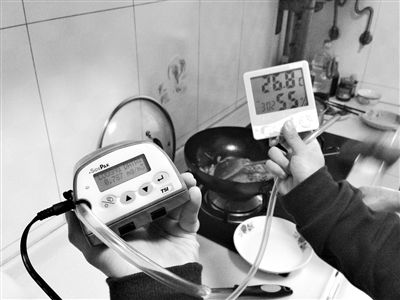Chinese cooking big contributor to PM 2.5 levels
- By Duan Yaying
 0 Comment(s)
0 Comment(s) Print
Print E-mail China.org.cn, October 16, 2013
E-mail China.org.cn, October 16, 2013
A recent experiment launched by the Beijing News has shown that the levels of PM 2.5, or fine particulate matter, can rise sharply to 787 micrograms per cubic meter from 38 in just five minutes of cooking traditional Chinese food.
 |
|
Stir-frying foods can produce higher levels of PM2.5, compared with boiling and steaming during indoor cooking test. [Photo: Beijing News] |
The result comes after a Beijing official blamed traditional cooking for pushing up PM 2.5 levels.
Zhao Huimin, director of the Beijing Foreign Affairs Office, said in an interview last Tuesday that in a large city, cooking contributes to high levels of PM 2.5, and citizens should do their bit to help curb air pollution in Beijing.
Researchers from the Nature University, a non-governmental environmental organization, were invited to carry out the experiment, which monitors changes in PM 2.5 levels caused by cooking different styles of Chinese food.
Xie Xinyuan, a researcher with the organization, said that traditional Chinese cooking methods, especially deep-fat frying and stir-frying, produce PM 2.5 particles to a extent that cannot be ignored.
Although the level is much smaller than the PM 2.5 particles from vehicle exhaust and industrial dust, it should not be underestimated because cooking fumes can carry harmful substances, Xie added.
Fan Zhihong, an associate professor in food science at China Agricultural University, also pointed out that cooking is an important contributor to air pollution. She said that higher cooking temperatures produce more PM 2.5 particles as well as cancerogenic toxins and aging substances.
PM 2.5 particles, with a diameter of 2.5 micrometers or less, are highly harmful if they enter the lungs.






Go to Forum >>0 Comment(s)